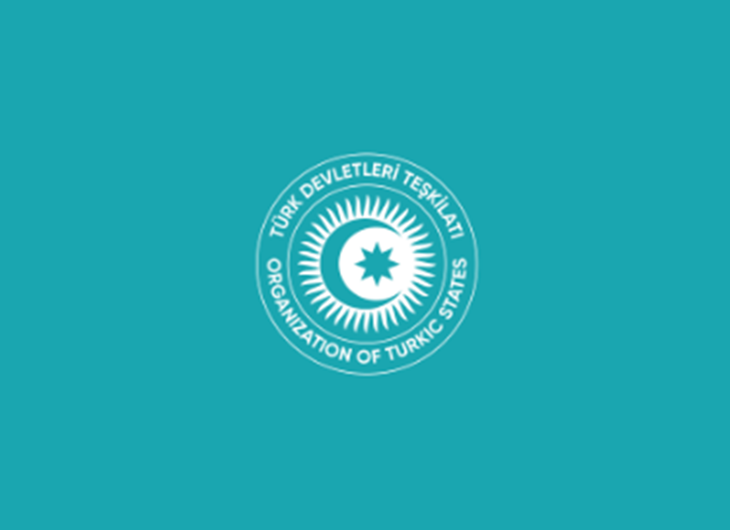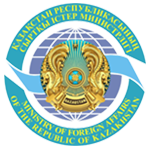Mr. Chairman,
Thank you for your kind introduction.
Distinguished Ministers,
Secretary General of Caspian Strategy Institute,
Dear participants,
Member of the press,
It is an honour to be here at the Second Caspian Forum and address the Panel session dedicated to Caspian Transit Corridor and revival of the Silk Road. I would like to express my gratitude to the Secretary General of Caspian Strategy Institute, Mr. Haldun Yavaş, for his kind invitation. During the last year, Turkic Council and the Institute have developed a well-established cooperative relation. We believe that this cooperative relation will pave the way for beneficial outcomes for Caspian region and beyond.
We, the Turks, are very old residents of the Caspian Area as indicated by the name we gave to the Caspian Sea “Hazar Denizi”, “Sea of the Hazar”, after the Turkic Empire that once ruled the region. Although at first glance the Caspian Sea seems to geographically divide landmass of Central Asia from the Caucasus and the Middle East, we consider it as another means of connectivity. Therefore, our main topic for discussion is how to transform this Sea into a transport corridor linking Central Asia, the Caucasus and beyond in all directions. Before going into discussing this topic, I would like to explain how we, as the Turkic Council, are involved in this.
Since its establishment in 2009 with the signature of Nakhchivan Agreement by Heads of State of Azerbaijan, Kazakhstan, Kyrgyzstan and Turkey, as a regional cooperation mechanism, Turkic Council is fully involved in increasing the level of connectivity among its members and in the region through various means. Besides its connotation in human and social relations, for Turkic Council, the term of “connectivity” refers to promotion of economic and trade relations through region-wide multi-modal transportation and pipeline networks.
We all know that “connectivity” is not a new phenomenon at all, and the seeds of connectivity between Europe and Asia were sowed by the Silk Road and its branches. Being situated between the eastern and western sides of the Caspian Sea as well as between the Black Sea and Mediterranean basins, Turkic Council Member States are located at the epicenter of strategic routes. Thanks to its geographical reach into three major regions, Turkic Council carries a big transport linkage potential not only for its Member States but also along the Silk Road. In this regard, the Caspian region, not only famous of its rich energy reserves but also of its significant potential for transit transport is on the top of the Turkic Council agenda.
Past of the Silk Road: Acclaimed as the “greatest route in the history of mankind”, the ancient Silk Road formed the first bridge between the East and West and was an important vehicle for trade between ancient empires of China, India, Persia and Rome. Dating back to 200 BC, the route was a channel for contact between people and cultures, inspiring the exchange of dialogue, art, religion, ideas and technology.
The uniqueness of the Silk Road, unlike other grand sea and land routes lies in the fact that it was neither created nor controlled in its entirety by a single authority or a group of states through its 12.000 kms. It was a route built and kept open by collaboration of different states and stakeholders motivated by common interests.
However, Turks, living in the main cities of the traditional Silk Road and adjacent lands played a significant role in boosting trade along this trajectory and providing its security. The Silk Road was so big and complex that its economic strengths and capabilities were unmatched by even its contemporary authorities. Although prominence of the Silk Road as a land route in world-wide trade started to decrease after 15th century with the discovery and utilization of new sea routes, its importance never disappeared. Despite varying quality, quantity and value of goods exchanged throughout the history, even in times of war, no matter “hot” or “cold”, the traditional Silk Road remained as the hearth of multidimensional relations between East and West; turning the Central Asian Countries from land-locked into land-linked countries.
Present of the Silk Road: - Collapse of the Soviet Union and intensification of globalization have brought new impetus to the Silk Road resulting in changes in its nature and function.
- In 21st century, European and Asian markets have become further liberalized. Following increased foreign trade as a result of new economic approaches, commodities of transit trade transported through the Silk Road have been diversified and multiplied. Commodities such as oil, gas, electricity and water have started to substitute “low in weight and high in price” commodities such as “silk” which was the item symbolically gave its name to this traditional road.
- Despite the increased need, geographical constraints and low logistic performances of the regional states have required to formulate a multi-modal transportation strategy with developed and connected rail, land and sea road infrastructure in the region.
- Moreover, the efforts to reintegrate a stable and secure Afghanistan into regional politics has drawn attention to the impact of transportation projects in 3Ps-Peace,Prosperity and Partnership.
- In the last decade, the trade volume of the Silk Road countries had quadrupled and there is noticeable shift in the rate of growth of these countries in contrast to Europe and other regions. According to estimates, average economic growth rate in the West stands at 3% while it is approximately 10% in the East. Turkic States having a population of 140 million, spanning an area of 5 million square km and with a GDP approximately 1.5 billion dollars constitute a significant part of this economic potential (according to the IMF statistics of 2012).
-Under these circumstances, we start to refer to a recalibrated version of the Silk Road, where Caspian Transit Corridor has a central role. And this role is related to its capacity to shorten the distance from Beijing to London. Eventfully, this potential that has been underestimated requires more attention and utilization.
Turkic Council’s focus on the Silk Road and Caspian Sea Crossing: With this in mind, last Turkic Council Summit of Heads of State focused on “transportation and connectivity”. Prior to the Summit, working groups on transportation and customs were convened several times. At the first meeting of Turkic Council Ministers of Transport held in June 2013 in Baku, an MoU on the establishment of Sister Seaport Relation and Cooperation among Baku, Aktau and Samsun Sea Ports was concluded, a Joint Cooperation Protocol on Transportation was signed and a decision to establish a Coordination Council at the level of Deputy Ministers was taken by Transport Ministers of Turkic Council.
Actually, the first meeting of Coordination Council will take place in Istanbul next week and Sister Sea Port authorities will come together in Samsun next month. The Coordination Council is expected to be a body addressing the practical problems faced by the transport operators on the spot. Being aware of the existing bottlenecks hampering effective transportation, Member States assigned officials from different modes of transport, along with representatives of operator companies, to attend the said meeting. In all documents signed or approved by Transport Ministers of the Turkic Council, the importance of connectivity within our region and beyond with a particular emphasis on role of Caspian Sea Crossing is underlined.
Let me give you a specific example to demonstrate the short-cutting role of Caspian Transit Corridor. It takes 23.000 km for a cargo loaded up in north western China to reach Europe via sea routes. If this cargo is transferred by the Silk Road passing through Caspian Sea, and then Baku-Tbilisi-Kars railway and Marmara Tunnel, it will only take 8500 km to reach Europe (according to a recent study of Economic Policy Research Foundation of Turkey-TEPAV). This is a fact that renders Central Corridor more attractive for East-West cargo transfer.
Let me give another striking example on this matter. Today, the main freight between Asia and Europe is realized by means of Suez Canal which takes around 45 days. Nevertheless, the new transportation networks utilizing the Caspian Sea connection could cut transport time to 10-12 days, as written in the publication of the Silk Road Institute named “The New Silk Roads: Transport and Trade in Greater Central Asia”.
To provide such a shortcut is of course possible by taking some actions. Removal of non-physical barriers such as lengthy procedures at border crossings is essential to this end. In this respect, a change of mentality and practice should occur. Customs should no longer be seen as both legal and illegal income generating instruments but should be rather considered as a trade facilitating one. We should also keep in mind that decreased bureaucracy will leave less room for abuse.
Developing harmonized and unified rules for transport modes, such as utilization of a common consignment note in railway cargo transport, optimization of tariffs, simplification of bureaucratic procedures and dissemination of online practices remain as some of measures to be taken to benefit from the advantages of the Caspian Transit Corridor. The costs of paperwork account for 3,5-7% of the value of the goods and even can be as high as 10-15% if there are typing and other errors, according to OECD 2002 and UNCTAD 1994 statistics.
For instance, at the moment, because of mainly non-physical barriers, such as lengthy procedures at border crossings, the average speed of a commercial truck between Central Asia and Turkey is lowered down to 17.5 km per hour. We do not have the luxury to lose such a time. According to a study of OECD conducted in 2011, every extra day required to ready goods for import or export decreases trade by around 4%. A decrease of 4 days to ready goods for import and export increases GDP per capita growth rate by 0,1%.
With this in mind, Turkic Council focuses to find out ways and means to foster cooperation in transportation and customs affairs among its Member States and the region. Our Member States have national and multilateral projects with the aim to utilize the potential of the Caspian Sea crossing. For example, “Silk Wind” Project of Kazakhstan as a high speed, multi-modal container bloc train project from China to Europe; “Caravanserai” Project of Turkey which focuses on increasing the efficiency of the Silk Road routes and particularly the border crossing points, Marmaray Tunnel that recently came into operation to connect Asia and Europe under the Bosphorus, and Baku-Tbilisi-Kars railway project that is to be finalized by the end of 2014 present steps taken to serve this aim. Moreover, developments on transportation infrastructure at the two sides of Caspian Sea are very promising.
Aktau Sea Port of Kazakhstan is getting enlarged and modernized. Its capacity is planned to be increased to 25 million tonnes, as it was put forward by the Minister of Transport of Kazakhstan at the Turkic Council First Meeting of Transport Ministers. To connect the Port into inner parts of the country, a new highway (approximately 400 km-long) between Aktau and Bieneu is being constructed. In addition, a critical component of the Silk Wind Project, Zhezkazgan-Bieneu railway construction, which is 988 km-long, will be finalized by 2015 and serve as an effective shortcut for the rail transport crossing Kazakhstan landmass, according to the Kazakh authorities.
On the other hand, apart from the modernization efforts for Baku Sea Port, according to the latest information provided by authorities, Azerbaijan is constructing another Sea Port named “Alyat Port” with a capacity of 20 million tonnes in Baku. Since the Turkic Council meeting held in May 2013 in Aktau between Aktau and Baku Sea Port authorities, both sides have worked to find out ways to develop Ro-Ro transportation across Caspian Sea with optimized tariffs and regular services for movement of goods. Moreover, extension of this cooperative relation between Baku and Aktau Ports to Turkmenbashı Sea Port of Turkmenistan is also in our agenda.
In this regard, after the conclusion of all these projects, the minimum amount of the freight to be transported through the Caspian Sea Crossing, just by redirecting the current land freight transport between Asia and Europe, is expected to be over 10 million tons per year. In fact, a short while ago Transport Minister of Azerbaijan announced that China alone guaranteed transportation of 10 million tonnes of cargo a year through the Baku-Tbilisi-Kars Railway after its completion. These are just rough statistics to show the potential that the Caspian Transit Corridor possesses in the context of the revival of the Silk Road.
Concluding Remarks: With extensive transportation lines, comprising road and railway network and reformed customs practices; energy corridors and pipelines, the Silk Road with Caspian Sea Crossing is turning into a significant player in the world economy. However, there is much to do to reveal this potential. Let’s focus on four points to make it real.
First, realization of this potential requires formulation of a legally enforced and strong multi-modal approach. UNECE and relevant organizations specialized on transport are working on the legal basis of a multi-modal transport strategy to be implemented in all over the world. The future of Caspian Transit Corridor is pretty much linked to the establishment and implementation of such an approach.
Second, ensuring involvement of private sector and enhancing public-private partnership on transport and customs issues is essential for modernization of Caspian Sea crossing and related connections of the Silk Road.
Third, achieving more transparent and streamlined customs formalities, modernizing facilities at border crossing points, providing acceleration and standardization of customs procedures, utilization of a common consignment note and dissemination of online practices for custom issues are among measures to minimize the time spent at border crossings and thus to render the Caspian Transit Corridor within Silk Road more attractive for transit transport in the region.
Last but not least, we need to focus on how to harmonize the projects related to the revival of the Silk Road. Alternative initiatives named after “New, Modern or True” Silk Road are endless. Facing a multiplicity in these initiatives is also related to differing agendas of different regional and extra-regional actors. If we can achieve to have common denominators for efforts regarding the revival of the Silk Road, we will be able to talk about not “great games” but “great gains” for the region and beyond. Thank you very much.
In interactive part of the panel:
Maritime-Land Transportation Comparison:
As you are aware to this day maritime transport is the most convenient for shippers and consignees. The fact is that, traditionally, transit cargo is carried by sea because of low cost, established relationships and good logistics infrastructure. The shipment time of the freight by sea is very long, the routes are overloaded (the number of containers to be transported from East to West in 2015 is estimated to be 10 million) and the ports are paralyzed by congestion and saturation problem. There is also a serious safety problem (risk of pollution following accidents). So today we are actively considering the development of multimodal transport corridors between East and West that would reduce the intensity of sea lines.








